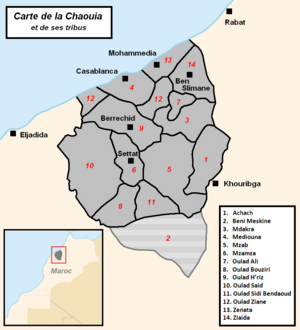Chaouia (Morocco) facts for kids
The Chaouia (pronounced Shaw-wee-ah) is a special historical area in Morocco. It's a region with its own unique geography and history. This area is bordered by the Oum er-Rbi' River to the southwest. The Cherrate River is to its northeast. To the southeast is the plain of Tadla, and the Atlantic Ocean is to the northwest. This region covers about 14,000 square kilometers. The name "Chaouia" also refers to a group of tribes who have lived there for a long time.
Contents
What Does "Chaouia" Mean?
The word "Chaouia" means "Land of Chaouis." The word "Chaoui" comes from a Berber language. It means "people who own sheep" or "shepherds." This shows how important sheep farming was in this region.
Exploring the Geography of Chaouia
Geographically, the Chaouia region has two main parts. There's the low Chaouia, which is closer to the coast. Then there's the high Chaouia, which is further inland. The soil in these areas can be very different. Some parts have dark, rich soil called "tirs." This soil is great for growing crops. Other areas have red soil known as "hamri" or "terra rossa."
For a long time, the Chaouia was famous for growing wheat and barley. When there was a lot of food, these crops were sent out from cities like Casablanca and Azemmour. Chaouia sheep were also well-known for their wool. This wool was even sent to places like Marseille in France. Today, the Chaouia is part of the Casablanca-Settat administrative region in Morocco.
A Look at Chaouia's History
Long ago, the Chaouia region was ruled by the Barghawata people. Later, it became part of Morocco under the Almoravids. In 1147, the Almohad ruler Abd al-Mu'min took control of Marrakesh. He then encouraged Bedouin Arab tribes to settle in the Chaouia area. This helped spread the Arabic language and made Arab groups more important in Morocco.
In the early 1900s, the Chaouia people strongly resisted the French. In 1907, the French attacked Casablanca. They then moved into the Chaouia region. Eventually, they took control of all of Morocco. During the time of the French protectorate, Chaouia was an "Autonomous subdivision of Casablanca." It was then divided into three smaller areas: Chaouia-North (around Casablanca), Chaouia-Center (around Berrechid), and Chaouia-South (around Settat).

Who Are the Chaouia Tribes?
The tribes of Chaouia have mixed backgrounds. They come from both Arab and Berber groups. Today, most of them speak Arabic. A French study from 1915 said that all these tribes claimed to be purely Arab. The Chaouia tribal group traditionally includes 14 tribes who speak Arabic:
| Tribe | Main Origin | Notes |
|---|---|---|
| Achach | Arab (Banu Sulaym) | |
| Beni Meskin | Arab | They joined the Chaouia in the 1800s. |
| Mdakra | Arab (Ahlaf and Sabbah) and Berber (Hawwara) | They merged with an older Barghawata group. |
| Mediouna | Berber (Zenata) | |
| Mzab | Berber (Zenata) | |
| Mzamza | Mainly Berber (Masmuda), with some later Arab parts | |
| Oulad Ali | Arab (Banu Ma'qil) | |
| Oulad Bouziri | Berber (Sanhaja) | |
| Oulad Hriz | Mainly Arab with some Berber origins | |
| Oulad Saïd | Arab (Zughba, Banu Hilal) | They settled here during the Marinid era. |
| Oulad Sidi Bendaoud | Mainly Berber (Sanhaja) | |
| Oulad Zyan | Arab (Zughba, Banu Hilal) | |
| Zenata | Berber (Zenata) | |
| Zyayda | Arab |


